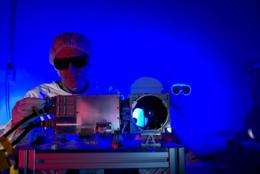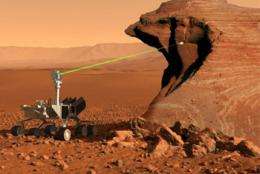Los Alamos instrument to shine light on Mars habitability

With the successful launch of the Mars Science Laboratory on Saturday, Los Alamos National Laboratory researchers and scientists from the French space institute IRAP are poised to begin focusing the energy of a million light bulbs on the surface of the Red Planet to help determine whether Mars was or is habitable.
The international team of space explorers that launched the Mars Science Laboratory last week is relying in part on an instrument originally developed at Los Alamos called ChemCam, which will use blasts of laser energy to remotely probe Mars’s surface. The robust ChemCam system is one of 10 instruments mounted on the mission’s rover vehicle, named Curiosity.
When ChemCam fires its extremely powerful laser pulse, it will vaporize an area the size of a pinhead. The system’s telescope will peer at the flash of glowing plasma created by the vaporized material and record the colors of light contained within it. These spectral colors will then be interpreted by a spectrometer, enabling scientists to determine the elemental composition of the vaporized material.
ChemCam can deliver multiple pulses in extremely rapid succession to a single area or quickly zap multiple areas, providing researchers with great versatility for sampling the surface of the planet.

“ChemCam is designed to look for lighter elements such as carbon, nitrogen, and oxygen, all of which are crucial for life,” said Roger Wiens, principal investigator of the MSL mission’s ChemCam team. “The system can provide immediate, unambiguous detection of water from frost or other sources on the surface as well as carbon—a basic building block of life as well as a possible byproduct of life. This makes the ChemCam a vital component of Curiosity’s mission.”
The system looks at the entire visible spectrum as well as portions on either side (the infrared and ultraviolet), which gives ChemCam the ability to see any element on the periodic table. ChemCam can zap an area about 23 feet away from the rover vehicle.
The system relies on a technology primarily developed at Los Alamos called laser-induced breakdown spectroscopy (LIBS). At the heart of the technology is an infrared laser (meaning it is invisible to the naked eye) that focuses more than a million watts of power onto a tiny area for five-billionths of a second. LIBS has successfully been used on Earth to determine the composition of objects within extreme environments such as inside nuclear reactors and on the sea floor. Other applications for LIBS include cancer detection and environmental monitoring. The Mars Science Laboratory is the technology’s first extraterrestrial use. The French national space agency, Centre National d’Études Spatiales, and France provided ChemCam’s laser and telescope. LANL supplied ChemCam’s spectrometers and data processors, and leads the overall investigation.
More than 30 people at LANL worked directly on the ChemCam instrument, and many others played supporting roles. Once the rover lands on Mars, LANL operations specialists will control the instrument.
Los Alamos also has roles in other aspects of the Mars Science Laboratory. DaveVaniman of LANL’s Earth and Environmental Sciences Division is deputy leader of another instrument called CheMin, which uses X-ray diffraction to determine the composition of mineral samples collected and dropped into a funnel on the Curiosity rover.
Los Alamos also provided the plutonium canisters that will provide power and heat to the rover, an effort that comprised the expertise of nearly 50 researchers and technicians. The power sources, called radioisotope thermoelectric generators (RTGs), will give Curiosity several times as much electricity asprevious-generation rovers, and are necessary for the much larger and more-advanced payload on Curiosity.
The Curiosity rover is expected to land on Mars on August 5, 2012, after traveling nearly 354 million miles from our planet. Curiosity will roam the planet’s surface for about 98 weeks, or the period of one Martian year.
Provided by Los Alamos National Laboratory





















